Leptis Magna
Leptis or Lepcis Magna, also known by other names in antiquity, was a prominent city of the Carthaginian Empire and Roman Libya at the mouth of the Wadi Lebdam in the Mediterranean.
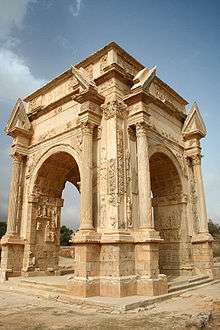 The Arch of Septimius Severus in Leptis Magna | |
 Shown within Libya | |
| Alternative name | Lepcis Magna, Neapolis, Lpqy |
|---|---|
| Location | Khoms, Libya |
| Region | Tripolitania |
| Coordinates | 32°38′21″N 14°17′26″E |
| Type | Settlement |
| History | |
| Founded | 7th c. BC |
| Abandoned | 7th c. AD |
| Periods | Iron Age to Byzantine |
| Cultures | Carthaginian Libyco-Berber Roman |
| Official name | Archaeological Site of Leptis Magna |
| Type | Cultural |
| Criteria | i, ii, iii |
| Designated | 1982 (6th session) |
| Reference no. | 183 |
| State Party | Libya |
| Region | North Africa |
Originally a 7th-century BC Phoenician foundation, it was greatly expanded under Roman Emperor Septimius Severus (r. 193–211), who was a native of the city. The 3rd Augustan Legion was stationed here to defend the city against Berber incursions. After the legion's dissolution under Gordian III in 238, the city was increasingly open to raids in the later part of the 3rd century. Diocletian reinstated the city as provincial capital, and it grew again in prosperity until it fell to the Vandals in 439. It was reincorporated into the Eastern Empire in 533 but continued to be plagued by Berber raids and never recovered its former importance. It fell to the Muslim invasion in c. 647 and was subsequently abandoned.
Its ruins are within present-day Khoms, Libya, 130 km (81 mi) east of Tripoli. They are among the best-preserved Roman sites in the Mediterranean.
Names
The Punic name of the settlement was written LPQ (Punic: 𐤋𐤐𐤒) or LPQY (𐤋𐤐𐤒𐤉).[1][2][3][4] This has been tentatively connected to the Semitic root (present in Arabic) LFQ, meaning "to build" or "to piece together", presumably in reference to the construction of the city.[2]
This name was hellenized as Léptis (Ancient Greek: Λέπτις)[5], also known as Léptis Megálē (Λέπτις μεγάλη, "Greater Leptis") distinguishing it from the "Lesser Leptis" closer to Carthage in modern-day Tunisia. It was also known by the Greeks as Neápolis (Νεάπολις, "New Town"). The latinization of these names was Lepcis or Leptis Magna ("Greater Leptis"), which also appeared as the "Leptimagnese City" (Latin: Leptimagnensis Civitas). The Latin demonym was "Leptitan" (Leptitanus). It was also known as Ulpia Traiana as a Roman colony.[4] Its Italian name is Lepti Maggiore; its Arabic name, Labdah (لَبْدَة).[6]
History
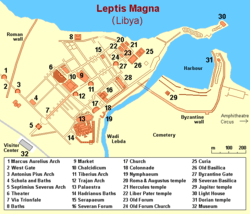
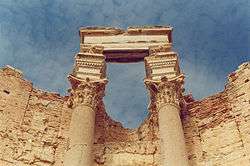
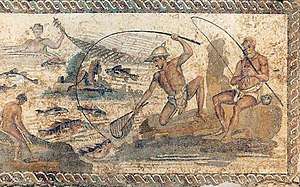
Phoenicians
The Phoenician city was founded in the second half of the 7th century BC. Little is known about Leptis during this time, but it appears to have been powerful enough to repel Dorieus's attempt to establish a Greek colony nearby around 515 BC.[3] Like most western Phoenician settlements, Leptis became part of the Carthaginian Empire and fell under Rome's control with Carthage's defeat in the Punic Wars. Leptis remained highly independent for a period after about 111 BC.
Roman Republic
The Roman Republic sent some colonists together with a small garrison in order to control the city. The city prospered and was even allowed to coin its own money in silver and bronze. Reflecting its blend of cultures, its coins bore Punic inscriptions but images of Hercules and Dionysus.[4] Soon Italian merchants settled in the city and started a profitable commerce with the Libyan interior.[7] The city depended primarily on the fertility of its surrounding farmland, where many olive-presses have been excavated. By 46 BC, its olive oil production was of such an extent that the city was able to provide three million pounds of oil annually to Julius Caesar as tax.[3]
Roman Empire
During the reign of Augustus, Leptis Magna was classified as a Civitas libera et immunis, or a free community, over which the governor had an absolute minimum of control. As such Leptis retain its two suphetes at the head of its government, with the mhzm, similar to the Roman aediles, as minor magistrates. In addition there were such sacred officials as the 'addir 'ararim or praefectus sacrorum, the nēquim ēlīm, and probably a sacred college of fifteen members. These offices were still in effective operation when Leptis was made a "Municipium" with a certain degree of Roman rights and privileges at some time between 61 and 68 A.D., during the rule of Nero.[8]
Leptis Magna remained as such until the reign of the Roman emperor Tiberius, when the city and the surrounding area were formally incorporated into the empire as part of the province of Africa. It soon became one of the leading cities of Roman Africa and a major trading post. The city grew rapidly under Roman administration. During the reign of Nero, an amphitheater was constructed. The settlement was elevated to municipium in AD 64 or 65 and to colonia under Trajan (r. 98 –117)
Leptis achieved its greatest prominence beginning in AD 193, as the hometown of emperor Septimius Severus. Septimius favored his hometown above all other provincial cities, and the buildings and wealth he lavished on it made Leptis Magna the third-most important city in Africa, rivaling Carthage and Alexandria. In AD 205, he and the imperial family visited the city and bestowed great honors. Among the changes that Severus introduced were the creation of a magnificent new forum and the rebuilding of the docks. The natural harbor had a tendency to silt up, but the Severan changes made this worse, and the eastern wharves are extremely well preserved, since they were scarcely used.
Leptis overextended itself during this period. During the Crisis of the 3rd Century, when trade declined precipitously, Leptis Magna's importance also fell into a decline, and by the middle of the 4th century, even before it was completely devastated by the 365 tsunami, large parts of the city had been abandoned. Ammianus Marcellinus recounts that the crisis was worsened by a corrupt Roman governor named Romanus, who demanded bribes to protect the city during a major tribal raid. The ruined city could not pay these and complained to the emperor Valentinian I. Romanus then bribed people at court and arranged for the Leptan envoys to be punished "for bringing false accusations". It enjoyed a minor renaissance beginning in the reign of the emperor Theodosius I.
Vandal Kingdom
In 439, Leptis Magna and the rest of the cities of Tripolitania fell under the control of the Vandals when their king, Gaiseric, captured Carthage from the Romans and made it his capital. Unfortunately for the future of Leptis Magna, Gaiseric ordered the city's walls demolished so as to dissuade its people from rebelling against Vandal rule. The people of Leptis and the Vandals both paid a heavy price for this in AD 523 when a group of Berber raiders sacked the city.
Byzantine Empire
Belisarius, general of Emperor Justinian I of the Byzantine Empire, recaptured Leptis Magna in the name of the Roman Empire ten years later, and in 533/4 it was re-incorporated into the empire. Leptis became a provincial capital of the Eastern Empire, but never recovered from the destruction wreaked upon it by the Berbers. In 544, under the prefecture of Sergius, the city came under intensified attack of Berber tribes, and after some successes, Sergius was reduced to retreating into the city, with the Leuathae tribal confederation camped outside the gate demanding payments. Sergius admitted eighty deputies into the city to present their demands, but when Sergius moved to leave the conference he was detained by the robe by one deputy and crowded by others. This provoked an officer of the prefect's guard to kill the deputy laying hands on the prefect, which resulted in a general massacre. The Berbers reacted with an all-out attack and Sergius was eventually forced to abandon Leptis and retreat to Carthage.[9]
Islamic conquest
By the 6th century, the city was fully Christianized.[10] During the decade 565–578 AD Christian missionaries from Leptis Magna even began to move once more among the Berber tribes as far south as the Fezzan in the Libyan desert and converted the Garamantes.[11] Numerous new churches were built in the 6th century,[12] but the city continued to decline, and by the time of the Arab conquest around 647 the city was mostly abandoned except for a Byzantine garrison force and a population of less than 1,000 inhabitants. Under Arab domination Leptis disappeared; by the 10th century the city was forgotten and fully covered by sand.[13]
Excavation
Today, the site of Leptis Magna is the site of some of the most impressive ruins of the Roman period.
Part of an ancient temple was brought from Leptis Magna to the British Museum in 1816 and installed at the Fort Belvedere royal residence in England in 1826. It now lies in part of Windsor Great Park. The ruins are located between the south shore of Virginia Water and Blacknest Road close to the junction with the A30 London Road and Wentworth Drive.
When Italians conquered Italian Libya in the early 20th century, they dedicated huge efforts to the rediscovery of Leptis Magna. In the early 1930s Italian archeological research was able to show again the buried remains of nearly all the city.[14] A 4th to 3rd century BC necropolis was found under the Roman theater.
In June 2005, it was revealed that archaeologists from the University of Hamburg had been working along the coast of Libya when they uncovered a 30 ft length of five colorful mosaics created during the 1st or 2nd century. The mosaics show with exceptional clarity depictions of a warrior in combat with a deer, four young men wrestling a wild bull to the ground, and a gladiator resting in a state of fatigue and staring at his slain opponent. The mosaics decorated the walls of a cold plunge pool in a bath house within a Roman villa at Wadi Lebda in Leptis Magna. The gladiator mosaic is noted by scholars as one of the finest examples of representational mosaic art ever seen—a "masterpiece comparable in quality with the Alexander Mosaic in Pompeii." The mosaics were originally discovered in the year 2000 but were kept secret in order to avoid looting. They are currently on display in the Leptis Magna Museum.[15]
There were unfounded reports that Leptis Magna was used as a cover for tanks and military vehicles by pro-Gaddafi forces during the 2011 Libyan civil war.[16] When asked about the possibility of conducting an air-strike on the historic site, NATO refused to rule out the possibility of such an action saying that it had not been able to confirm the rebels' report that weapons were being hidden at the location.[17]
Gallery
- Columns (on the stage)
.jpg) Columns (on the stage)
Columns (on the stage)- Ruins
- Small Gate (Western side)
 Theater
Theater.jpg) Theater (side view)
Theater (side view)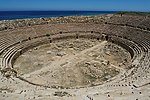 Amphitheater
Amphitheater Marketplace
Marketplace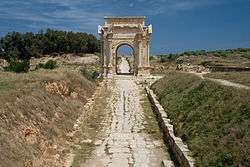 Arch of Septimius Severus
Arch of Septimius Severus Some of Leptis Magna yet to be excavated
Some of Leptis Magna yet to be excavated- One of the entrances to the theater (external view)
- View on Leptis Magna from the theater wall
- Street view (from Arch of Septimius Severus arch to Arch of Trajan)
- Market place
- Market place
- Measure converter, Market (founded 8 or 9 BC) (Phoenician colony)
- Severan Basilica, Leptis Magna 2nd century AD
- Stairs inside Septimius Severus Basilica
- Decorative columns inside Basilica of Septimius Severus
- Severan Basilica
- Forum in Leptis Magna, 2nd century AD
See also
References
Citations
- Ghaki (2015), p. 67.
- Edward Lipiński, Itineraria Phoenicia (2004), p. 345.
- Brogan, Wilson, "Lepcis" in: The Oxford Classical Dictionary (4th ed. 2012), p. 821.
- Head & al. (1911).
- Strabo, Geography, §17.3.18
- "لَبْدَة Libya". Retrieved 2010-09-06..
- Silvia Bullo: Provincia Africa. Leptis Magna. pg 167–171. (in Italian)
- Kenneth Matthews. Cities in the sand: Leptis Magna
- Frederick William Beechey, Henry William Beechey Proceedings of the Expedition to Explore the Northern Coast of Africa (1828), 54f.
- Theodore Mommsen. "The Provinces of the Roman Empire". section:Africa
- The last native Christian communities in north Africa
- Byzantine churches in Leptis Magna
- Silvia Bullo. Provincia Africa: Leptis Magna. pp. 185–188
- Archeological research on Leptis Magna territory
- Alberge, Dalya, (The Times Online, June 13, 2005)
- "Misrata update and comments for June 7th and 8th". Libya 17th February. Archived from the original on 25 December 2013. Retrieved 10 June 2011.
- "CNN Wire Staff". Web Article. 14 June 2011. Retrieved 2011-06-14.
Bibliography
- Bullo, Silvia. Provincia Africa: le città e il territorio dalla caduta di Cartagine a Nerone. Editore L'Erma di Bretschneider. Roma,2002 ISBN 8882651681
- De Miro, Ernesto & Antonella Polito. Leptis Magna. Dieci anni di scavi archeologici nell area del Foro Vecchio. I livelli fenici, punici e romani. L’Erma di Bretschneider, Rom 2005, ISBN 88-8265-309-9.
- Floriani Squarciapino, Maria. Leptis Magna. Raggi, Basel 1966 (Ruinenstädte Nordafrikas 2).
- Ghaki, Mansour (2015), "Toponymie et Onomastique Libyques: L'Apport de l'Écriture Punique/Néopunique" (PDF), La Lingua nella Vita e la Vita della Lingua: Itinerari e Percorsi degli Studi Berberi, Studi Africanistici: Quaderni di Studi Berberi e Libico-Berberi, No. 4, Naples: Unior, pp. 65–71, ISBN 978-88-6719-125-3, ISSN 2283-5636. (in French)
- Head, Barclay; et al. (1911), "Syrtica", Historia Numorum (2nd ed.), Oxford: Clarendon Press, p. 875.
- Kreikenbom, Detlev, "Leptis Magna vor der arabischen Eroberung," in Detlev Kreikenbom, Franz-Christoph Muth, Joerg Thielmann (hg), Arabische Christen – Christen in Arabien (Frankfurt am Main u.a., Peter Lang, 2007) (Nordostafrikanisch / Westasiatische Studien, 6), 35–54.
- Mommsen, Theodore. The Provinces of the Roman Empire. Barnes & Noble Ed. New York, 2003
- Robin, Daniel. The Early Churches in North Africa (The Holy Seed). Tamarisk Publications. Chester, 1993 ISBN 978 0 9538565 3 4
- Richard Talbert. Barrington Atlas of the Greek and Roman World, (ISBN 0-691-03169-X), p. 35.
- Tomlinson, Richard A. (1992). From Mycenae to Constantinople: the evolution of the ancient city. New York: Routledge. ISBN 0-203-72114-4..
External links
| Wikimedia Commons has media related to Leptis Magna. |
- Babelon, E.C.F. (1911). . Encyclopædia Britannica. 16 (11th ed.). p. 482.
- Comprehensive website, by an archaeologist working on the site
- Livius.org: Lepcis Magna
- The Main Site at Leptis Magna – Satellite View on Google Maps
- The circus (top) and amphitheater of Leptis Magna – Satellite View Google Maps
- Complete photo coverage of Leptis Magna
- Mattingly, D., R. Talbert, T. Elliott, S. Gillies. "Places: 344448 (Neapolis/Lepcis Magna)". Pleiades.CS1 maint: multiple names: authors list (link)
- Official UNESCO page
- Photos, location map and info
- Libyan Revolution and NATO Propaganda – The Post Hole
- 360 degree Panoramic Photograph

%2C_Algeria_04966r.jpg)